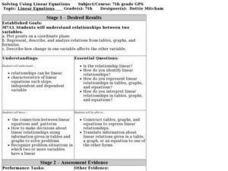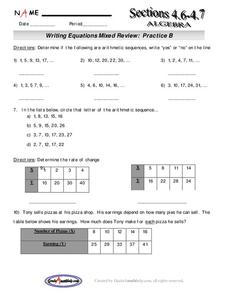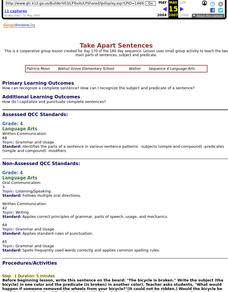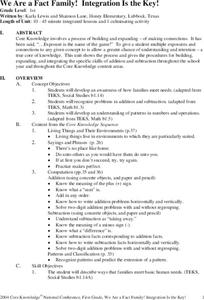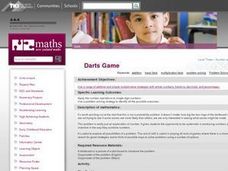Curated OER
Solving Using Linear Equations
Seventh graders explore linear equations. They observe the relationship between linear equations an patterns. Students make decisions using information given in graphs to solve linear equations. They perform a toothpick activity to...
Curated OER
Time Machine: Evolution, Geology
Students are taken on a simulated "voyage" backward in time, to the beginning of our planet. They "witness" that beginning, the origin of life, and a number of key events from then to the present.
Curated OER
Writing Equations Mixed Review
Learners write equations based on a pattern. In this algebra lesson, students calculate the arithmetic and geometric mean of a sequence. They rewrite word problems as a linear equation and solve real life scenario based on the given data.
Curated OER
J.S. Bach (1685-1750): Sarabande and Gigue form Partita no.4 in D major, BWV 828
Challenge your music students with this worksheet, which includes twenty-one questions about J.S. Bach's Sarabande and Gigue form Partita no.4 in D major, BWV 828. Students compare the two sections (bars 1-12, bars 13-38) by answering...
Curated OER
Earliest Americans
Students study the Earliest Americans. In this interactive lesson on the Native Americans, students study different tribes over the course of seven lessons. Students culminate their studies with a presentation and assessment.
Curated OER
Take Apart Sentences
Fourth graders explore the two main parts of sentences, subject and predicate. They, in groups, mix up their sentence strips and then place them face down and have a contest to see which group can rebuild the sentences correctly in the...
Curated OER
Through the Eyes of an Owl
Students describe vertebrates in terms of observable body parts and characteristics and describe life cycles of familiar organisms. They identify familiar organisms as part of a food chain or food web and describe their feeding...
Curated OER
Tantalizing Tessellations Lesson III: Creating a Slide Translation
Students explore tessellations and the artwork of M.C. Escher. They view and discuss a video about M.C. Escher, create a slide template out of cardboard, and create a poster with their tessellation pattern.
Curated OER
Butterfly Adventure
Students in second grade are paired with fifth grade computer research buddies. They observe the characteristics of caterpillars, and identify the four stages of the caterpillar to butterfly life cycle. They graph the number of...
Curated OER
Can't You Make Them Behave, King George?
Fifth graders describe the changes in King George III's policy toward the American colonies by sequencing key events between the French and Indian War and the American Revolution. They explain the colonial reactions to command decisions...
Curated OER
Global Greenup
Students utilize satellite images to track the life cycle of vegetational growth over a large area. Animal migratory patterns are compared to this cycle.
Curated OER
Building Shapes From Numbers
Students experience how to illustrate some of the many connections between number and geometry. Through this 2-3 day focus on square numbers and triangular numbers, students make connections among mathematical topics.
Curated OER
Comparing Costs
Students compare the costs of two cellular phone plans and determine the best rate. They use a table and a graph of points plotted on a Cartesian plane to display their findings. Students write an equation containing variables that could...
Curated OER
Tearing a Piece of Paper in Half
In this secondary mathematics activity, students investigate exponential growth as they predict the height of a stack of paper formed by tearing one sheet of paper in half over and over again for thirty tears. The one page activity...
NASA
Benford's Law
In this Benford's Law learning exercise, high schoolers read about the first digit frequency of numbers. Students solve 3 problems about sunspot numbers, solar wind magnetism and the depth of the latest earthquakes by using on line sites...
Curated OER
Pigs, Pigs, Pigs!
Third graders find information about different breeds of pigs using the Internet, books, and encyclopedias. Groups select one breed of pig that interests them. They construct a stuffed likeness of the pig.
Curated OER
Chords and Triads
In this music worksheet, students answer 15 questions related to chords and triads. For example, "A triad is a ...that is made up of three notes."
Curated OER
We Are a Fact Family! Integration Is the Key!
Students practice addition and subtraction. In this fact families unit, students practice finding sums and differences for fact families. This unit includes ten lessons with science and social studies integration.
Curated OER
Food Pyramid Power: Looking Back and Moving Forward
Students show their knowledge of properties of objects as it pertains to sorting and creating patterns. In this food pyramid power lesson plan, students show their ability to use whole numbers in different representations by appling...
Curated OER
"A Pig is Big"
Students explore the concept of big, bigger, and biggest. They examine and classify items by size, listen to and discuss the book "A Pig is Big," complete a fill in the blank activity, and create a tri-fold that illustrates two items...
Curated OER
And The Twelfth One Is
Ninth graders play guess my shape (either describe or use a feely bag to introduce the 3 shapes in the problem.) As they are identified put them in an order as shown in the problem. As the students work on the problem in pairs teacher...
Curated OER
Sequencing the Daily Calendar
Students identify the passage of time. They also practice with basic mathematical concepts.
Curated OER
Darts Game
Third graders attempt to determine what the scores of the game in the problem could be. They work with basic multiplication facts to justify the solutions to a dart game and share all of the possible scores.
National Security Agency
Multiple Representations of Limits
After an introductory activity to demonstrate the theory of a limit, additional activities approach a limit from graphical, numerical, and algebraic methods. The activity looks at the multiple ways of understanding and evaluating a limit.


